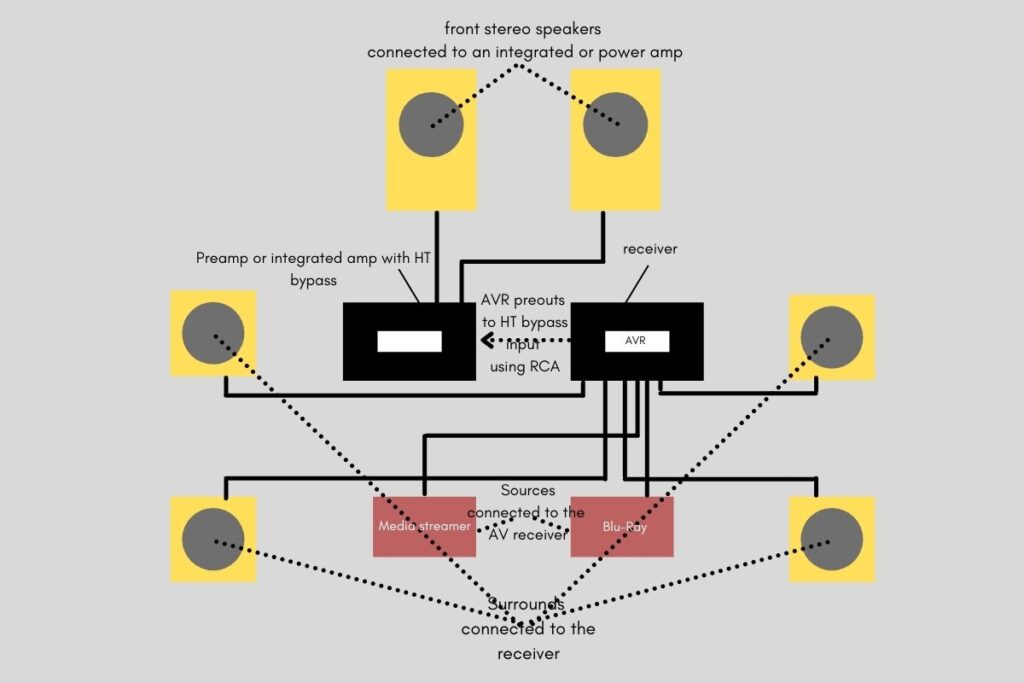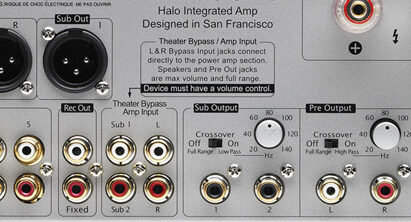Home theater bypass or HT bypass is a line-level input connection on high-end preamps or integrated amps that bypasses their audio processing and compression for 2-channel audio. This allows a home theater to double as a hi-fi music room.
To use this feature, an AV with the front left and right preouts is required as AVRs are not ideal for Hi-Fi stereo.
For music purists, HT bypass is handy as it allows them to indulge in movies and music in one room.
Here’s how it works…
How home theater bypass works
Integrated amps with HT bypass allow home theater users to use their front left and right speakers for both 2-channel Hi-Fi and surround sound (5.1, 7.1…).
Thus, you can listen to uncompressed audio from a CD player, turntable, or other sources since the audio processing on the integrated is bypassed. Audio processing is great for movies but not so much for Hi-Fi.
Additionally, with this feature, you don’t have to tweak the volume level, gain, or EQ for the front left and right speakers each time you switch between 2-ch and surround sound. This, the volume level is set on the AV receiver.
However, not all integrated amps or preamps have this feature. Check the specs sheet for RCA inputs labeled as “Home theater bypass“, “Direct“, “Tape“, or “Processor input“.
Connecting home theater bypass
You need 2 RCA cables to complete the connection between the AVR’s left and right preouts and the corresponding bypass inputs on an integrated or preamp.
This bypasses the preamp stage gain on the integrated allowing you to use it purely as a stereo power amplifier.
With this, volume adjustments are done at the source or surround-sound processor (AVR).

What this means
You don’t have to splash money on a dedicated music room as you will be able to switch between surround sound and 2-channel Hi-Fi with one press of a button without needing an external switch.
All you will need is;
- A surround sound processor with a preout section,
- An integrated amp or a preamp with HT bypass and a power amp
The center, surround, and/or height speakers will be powered by the AV receiver while an integrated or power amp powers the front left, and right speakers. Thus, the front left and right audio channels pass unprocessed to the stereo amp.
The gain on the second preamp stage is also bypassed and the AVR for used for volume adjustment for stereo surround sound.
HT bypass alternative
This alternative is useful for stereo amps that lack HT bypass for combining stereo and surround sound.
Plug the front left and right speakers into the stereo amp or preamp and all the other speakers to the relevant terminals on the AV receiver (center, surround, height).
Connect the front left and right preouts on the receiver to the respective inputs on the amp. You may need to assign the preouts on some receivers (amp assign).
Then connect your stereo sources to your preamp or integrated and the surround sound sources to the receiver.
Fine-tune the volume levels to ensure output is consistent for all speakers.
Drawbacks;
- Possible sonic inconsistencies between speakers.
- Expensive. (a bypass setup is also expensive).
- Unlike HT bypass, sources are switched manually.
Cost is one of the biggest drawbacks to both setups. However, with HT bypass, switching sources is done with the receiver remote.
To Sum up
If you are not too keen on Hi-Fi stereo, a bypass preamp or integrated amp will be of no use to you.
However, for audiophiles that don’t have the luxury of separate music and movie rooms, this feature will come in handy with the biggest upgrade cost being taken up by an integrated or preamp with HT bypass.
With that said, preamps or integrated amps with HT bypass can be quite expensive.


